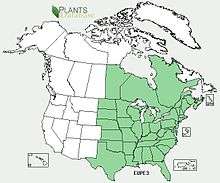Eupatorium perfoliatum
| Eupatorium perfoliatum | |
|---|---|
| | |
| Scientific classification | |
| Kingdom: | Plantae |
| (unranked): | Angiosperms |
| (unranked): | Eudicots |
| (unranked): | Asterids |
| Order: | Asterales |
| Family: | Asteraceae |
| Genus: | Eupatorium |
| Species: | E. perfoliatum |
| Binomial name | |
| Eupatorium perfoliatum L. | |
 | |
| Synonyms[2] | |
|
Synonymy
| |
Eupatorium perfoliatum or (common) boneset is a common North American perennial plant in the sunflower family. It is native to the Eastern United States and Canada, widespread from Nova Scotia to Florida, west as far as Texas, Nebraska, the Dakotas, and Manitoba.[3][4] It is also called "agueweed", "feverwort" or "sweating-plant". It was introduced to American colonists by Indians who used the plant for breaking fevers by means of heavy sweating. It is nearly always found in low, wet areas and is often found near Phalaris arundinacea (reed canary grass).
Description

Eupatorium perfoliatum grows up to 100 cm (39 inches) tall, with leaves that clasp the stems. The plant produces and dense clusters of tiny white flower heads held above the foliage.
The leaves growing together around the stem lead to a past superstition that wrapping the leaves in bandages around splints would help mend broken bones.[5] Boneset also had other medical uses,[5] and was a very common remedy in the United States in the 19th century.[6] The common name boneset apparently derives from the plant's historical use in treating dengue fever (which is also known as breakbone).[7]
Eupatorium perfoliatum can form hybrids with other species of the genus Eupatorium, for example Eupatorium serotinum.[3]
Medicinal uses
Eupatorium perfoliatum was used in the traditional medicine of Native Americans and extracts are now used in herbal medicine for fever and colds.[8] The effects of Eupatorium perfoliatum have not been confirmed by clinical study.[8] However, animal studies and in vitro experiments with plant extracts indicate possible anti-inflammatory effects and activity against Plasmodium falciparum, the parasite that causes malaria.[8]Also used in homeopathy.
Butterflies
Eupatorium perfoliatum is a specific butterfly food and habitat plant.
See also
References
- ↑ "Eupatorium perfoliatum". NatureServe Explorer. NatureServe. Retrieved 2010-09-12.
- ↑ The Plant List, Eupatorium perfoliatum L.
- 1 2 "Eupatorium perfoliatum". Flora of North America (FNA). Missouri Botanical Garden – via eFloras.org.
- ↑ "Eupatorium perfoliatum". County-level distribution map from the North American Plant Atlas (NAPA). Biota of North America Program (BONAP). 2013.
- 1 2 Audubon Society Field Guide To Wild Flowers – Eastern Region – 1979
- ↑ Mrs. M. Grieve (1931). "Boneset". A Modern Herbal.
- ↑ George Diggs, Barney Lipscomb, Robert O'Kennon (Author), Barney Lipscomb (Editor), Linny Heagy (1999). Shinners & Mahler's Illustrated Flora of North Central Texas. ISBN 978-1-889878-01-0.
- 1 2 3 Hensel, Andreas; Maas, Mareike; Sendker, Jandirk; Lechtenberg, Matthias; Petereit, Frank; Deters, Alexandra; Schmidt, Thomas & Stark, Timo (2011). "Eupatorium perfoliatum L.: Phytochemistry, traditional use and current applications". Journal of Ethnopharmacology. 138 (3): 641–651. doi:10.1016/j.jep.2011.10.002.
External links
![]() Media related to Eupatorium perfoliatum at Wikimedia Commons
Media related to Eupatorium perfoliatum at Wikimedia Commons
![]() Data related to Eupatorium perfoliatum at Wikispecies
Data related to Eupatorium perfoliatum at Wikispecies
| Wikiversity has bloom time data for Eupatorium perfoliatum on the Bloom Clock |
